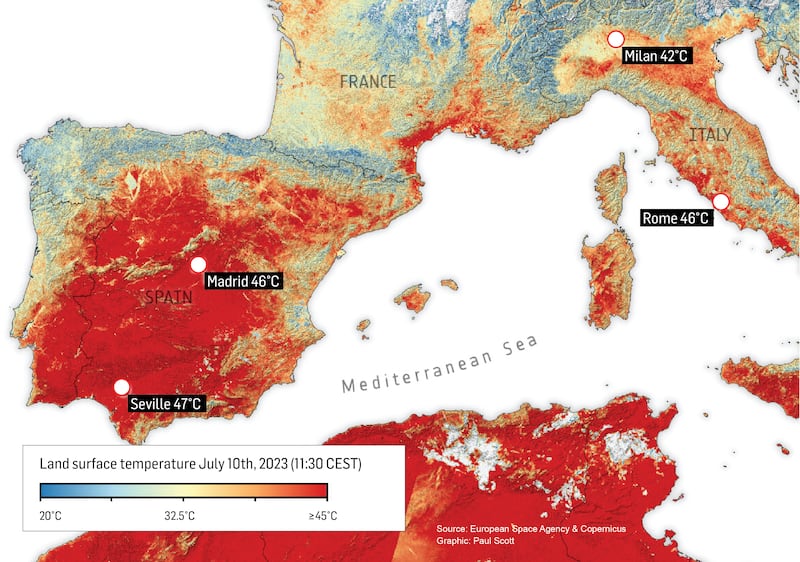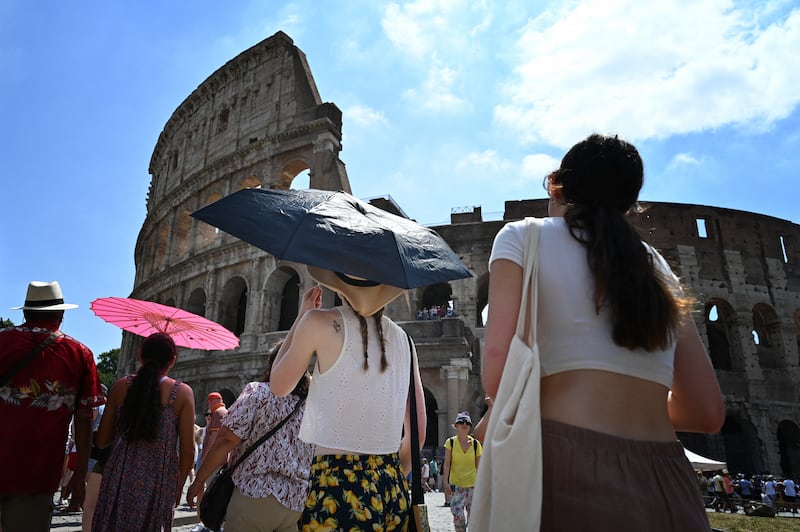Three brothers were working on a vineyard near the Spanish farming village of Cinco Casas as this summer’s heatwaves began to hit Europe, when one of them began to feel ill and collapsed.
The 46-year-old was taken by his siblings to a local health clinic and then transferred to hospital where he died a short time later, local authorities said, a victim of brutal heat that has swept across Europe as part of increasingly severe and deadly extreme weather attributed to climate change.
“We have learned of the death of the farmer, who is from Tomelloso, in the vicinity of Cinco Casas,” the village mayor Almudena Moya told local radio. “It was the result of a heat stroke due to the high temperatures. It is awful news, we are somewhat in shock.”
Two deadly heatwaves have hit Europe so far this summer: Cerberus, named after a monstrous hound from Greek mythology, and Charon, the boatman who brings the souls of the dead into the underworld.
READ MORE
“Italy, Spain, France, Germany and Poland are all facing a major heatwave with temperatures expected to climb to 48°C on the islands of Sicily and Sardinia – potentially the hottest temperatures ever recorded in Europe,” the European Space Agency warned on Thursday.
Its Copernicus satellite registered land surface temperatures of 46 degrees in Rome and Madrid and temperatures over 50 degrees on the east slopes of Mount Etna in Sicily, levels that raise the risk of catastrophic wildfires while also being dangerous for human health.

Last week was the world’s hottest on record, according to the UN’s World Meteorological Organisation (WMO), and was described by some scientists as the Earth’s warmest period in 100,000 years.
It followed the hottest June on record, and the WMO warned that Antarctic ice cover had dropped to a record low.
Ireland has not escaped the heat. An exceptional marine heatwave was recorded off the Irish coast in June, triggering alarm over the impact on fish populations and the knock-on consequences, because North Atlantic temperatures drive hurricanes and tropical cyclones, as well as heavy rain or drought in West Africa.
“The temperatures in the North Atlantic are unprecedented and of great concern. They are much higher than anything the models predicted,” said Dr Michael Sparrow, head of WMO’s World Climate Research Department. “This will have a knock-on effect on ecosystems and fisheries and on our weather.”
Long-term data shows the world has steadily warmed since the pre-industrial age, and the WMO has warned that there is a 50/50 chance that global average temperatures will breach 1.5 degrees above pre-industrial levels in the next five years.
The 1.5 degree level is key because international leaders committed to keeping global warming below that level in the 2015 Paris Agreement, because the damage and cost of climate change to the natural world, livelihoods and human lives is increasingly severe beyond that.
Coinciding with this, for the first time in seven years, scientists have detected the onset of El Niño conditions in the tropical Pacific, heralding the start of a natural year-long warming fluctuation expected to exacerbate disruptive weather and hot temperatures.
“We are in uncharted territory and we can expect more records to fall as El Niño develops further and these impacts will extend into 2024,” the WMO’s director of climate services Christopher Hewitt warned. “This is worrying news for the planet.”

As the heat intensifies, tourists and locals in Europe’s holiday hotspots have been warned to avoid activity outside during the hottest hours of the day.
A tourist collapsed “due to the heat” at the Acropolis and was brought by stretcher to a waiting ambulance, Greek police said on Friday. Local media reported the ancient site would close between 12pm and 3pm due to temperatures exceeding 40 degrees.
The farmer who died in Cinco Casas, in south central Spain, was the second officially recorded heat fatality in that country, after a 47-year-old collapsed after ploughing in his family’s olive grove in the southern province of Seville. In Italy on Tuesday, a 44-year-old worker who was painting road markings on an unshaded road collapsed and died, prompting an outcry by unions.
[ Climate change is scarring Europe, and southern countries most of allOpens in new window ]
Yet a study released in the journal Nature this week suggests that the true toll of the heat is far higher.
By comparing regional temperature rises with records of deaths, the authors estimated that there were 61,672 “heat-related deaths in Europe” in the summer of 2022, as mortality rates spiked, particularly among the elderly, when the hot weather hit.
The greatest toll was in Italy, followed by Spain and Germany, while people also died in Portugal, France, Greece and the United Kingdom in what the paper described as the “hottest season on record in Europe”.
If the trend continues, the paper estimated that Europe should expect an average of 68,116 heat-related deaths each summer by the year 2030, 94,363 by 2040, and 120,610 by 2050 “unless strong mitigation and adaptation actions are put in place”.



















